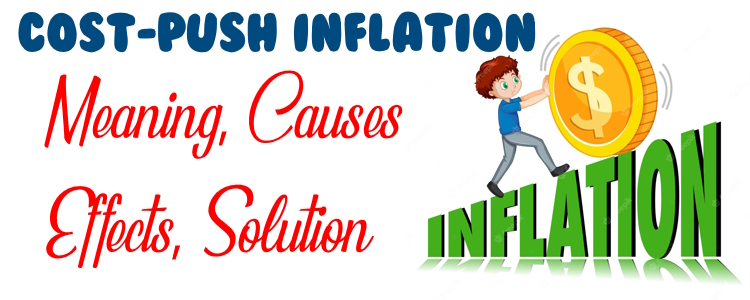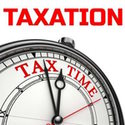Cost-Push Inflation | Meaning | Causes | Effects | Solution
Inflation refers to the sustained and gradual increase in the overall price level of goods and services in an economy, leading to a decrease in the purchasing power of a currency over time.. There are various types of inflation, and cost-push inflation is one of them. In this article, we will explore the causes, effects, and solutions of cost-push inflation.

Table of Contents
What is Cost-Push Inflation?
Cost-push inflation is a type of inflation that occurs due to an increase in production costs, such as labor, raw materials, and energy. When the costs of production rise, businesses have to spend more money to produce goods and services. As a result, they may increase the prices of their products to maintain their profit margins, leading to inflation.
Causes of Cost-Push Inflation
There are various factors that can lead to cost-push inflation. Here are a few prevalent causes that contribute to this type of inflation:
Increase in Production Costs
The most common cause of cost-push inflation is an increase in production costs. This can be due to an increase in the cost of raw materials, energy, or labor. When the cost of producing goods and services increases, businesses may raise their prices to maintain their profit margins.
Increase in Wages
If there is an increase in wages due to labor unions or government policies, it can lead to cost-push inflation. When wages increase, businesses have to spend more money on labor costs, which can result in higher prices for goods and services.
Natural Disasters
Natural disasters such as floods, hurricanes, and earthquakes can disrupt the supply chain and lead to an increase in production costs. When businesses have to spend more money on transportation or import costs, it can result in higher prices for goods and services.
External Shocks
External shocks, such as natural disasters or political instability, can cause cost-push inflation by disrupting the supply chain and increasing the cost of production. For example, a hurricane that destroys crops can lead to a shortage of food, which can cause the price of food to increase.
Political instability in a major oil-producing country can cause supply disruptions and lead to a sharp increase in oil prices. This, in turn, can raise the cost of production for businesses that rely on oil or petroleum products, leading to higher prices for goods and services across the economy. Political instability can also lead to disruptions in international trade and investment, causing further inflationary pressures.
For instance, if a country experiences political turmoil, it may lead to a decline in foreign investment, which can limit the supply of capital and slow down economic growth. This can also lead to a decline in the value of the country’s currency, making imports more expensive and contributing to cost-push inflation.
Trade Policies
Trade policies, such as tariffs or quotas, can cause cost-push inflation by increasing the cost of imports. When the cost of imports increases, domestic producers may raise their prices to remain competitive. Additionally, trade policies can lead to retaliation by other countries, which can cause a trade war that further increases costs and prices.
Effects of Cost-Push Inflation
Cost-push inflation can have several negative effects on the economy. Here are some of the most common effects:
Decrease in Purchasing Power
As prices rise faster than incomes, consumers may find it difficult to maintain their standard of living. This can result in a decrease in purchasing power and a decline in consumer confidence.
Reduced Economic Growth
Cost-push inflation can lead to reduced economic growth by reducing the availability of goods and services. When prices increase due to cost-push inflation, consumers may have to spend more money on basic necessities, leaving less money available for discretionary spending. This can reduce demand for goods and services, which can lead to decreased economic growth.
Increased Unemployment
Cost-push inflation can also lead to increased unemployment. When production costs increase, businesses may have to lay off workers or reduce their hours to maintain profitability. This can lead to higher unemployment rates, which can have negative consequences for individuals and the economy as a whole. Additionally, high inflation can lead to reduced foreign investment, which can further reduce job opportunities.
Reduced Competitiveness
Cost-push inflation can reduce the competitiveness of domestic producers in international markets. When production costs increase, domestic producers may have to increase their prices, making them less competitive compared to foreign producers who have lower production costs. This can lead to a decline in exports and a worsening of the balance of trade.
Decreased Consumer Confidence
Cost-push inflation can decrease consumer confidence, as consumers may worry about their ability to afford basic necessities or future purchases. A decrease in consumer spending, as a result of higher prices, can cause a slowdown in economic activity, leading to a negative impact on the overall economy. Additionally, decreased consumer confidence can lead to reduced business investment, as businesses may become more cautious in their spending decisions.
Solutions to Cost-Push Inflation
Cost-push inflation can be difficult to control, as it originates from external factors such as changes in global commodity prices or supply shocks. However, here are some solutions that can help mitigate the effects of cost-push inflation:
Increase in Productivity
One of the ways to reduce production costs is to increase productivity. This can be done by investing in technology, training, and research and development. By increasing productivity, businesses can reduce their costs and maintain their profit margins without increasing prices.
Government Intervention
The government can also intervene to control cost-push inflation. This can be done by implementing policies that reduce production costs, such as subsidies for raw materials or energy, or tax breaks for businesses that invest in technology.
Wage Controls
The government can also implement wage controls to prevent excessive increases in wages. This can be done by setting a minimum wage or implementing policies that limit wage increases.
Price Controls
Price controls can be used to prevent producers from raising prices in response to increased costs. For example, governments can impose price ceilings on certain goods and services to prevent them from becoming too expensive. However, price controls can have negative consequences, such as shortages or black markets, and need to be carefully implemented.
Investment in Technology and Research
Investment in technology and research can help reduce production costs and increase efficiency. This can help reduce the impact of cost-push inflation by increasing the supply of goods and services without increasing their cost. Additionally, innovation can lead to the development of new products and services, which can create new markets and increase economic growth.
Conclusion
Cost-push inflation is a type of inflation that occurs due to an increase in production costs. It can have several negative effects on the economy, such as a decrease in purchasing power, reduced economic growth, and increased unemployment.
While cost-push inflation can be difficult to control, solutions such as implementing policies that aim to reduce production costs, promoting competition in markets, and investing in research and development to increase productivity can help mitigate the negative effects of cost-push inflation. It is essential to adopt a balanced and comprehensive approach to manage cost-push inflation to maintain stability in the economy.


